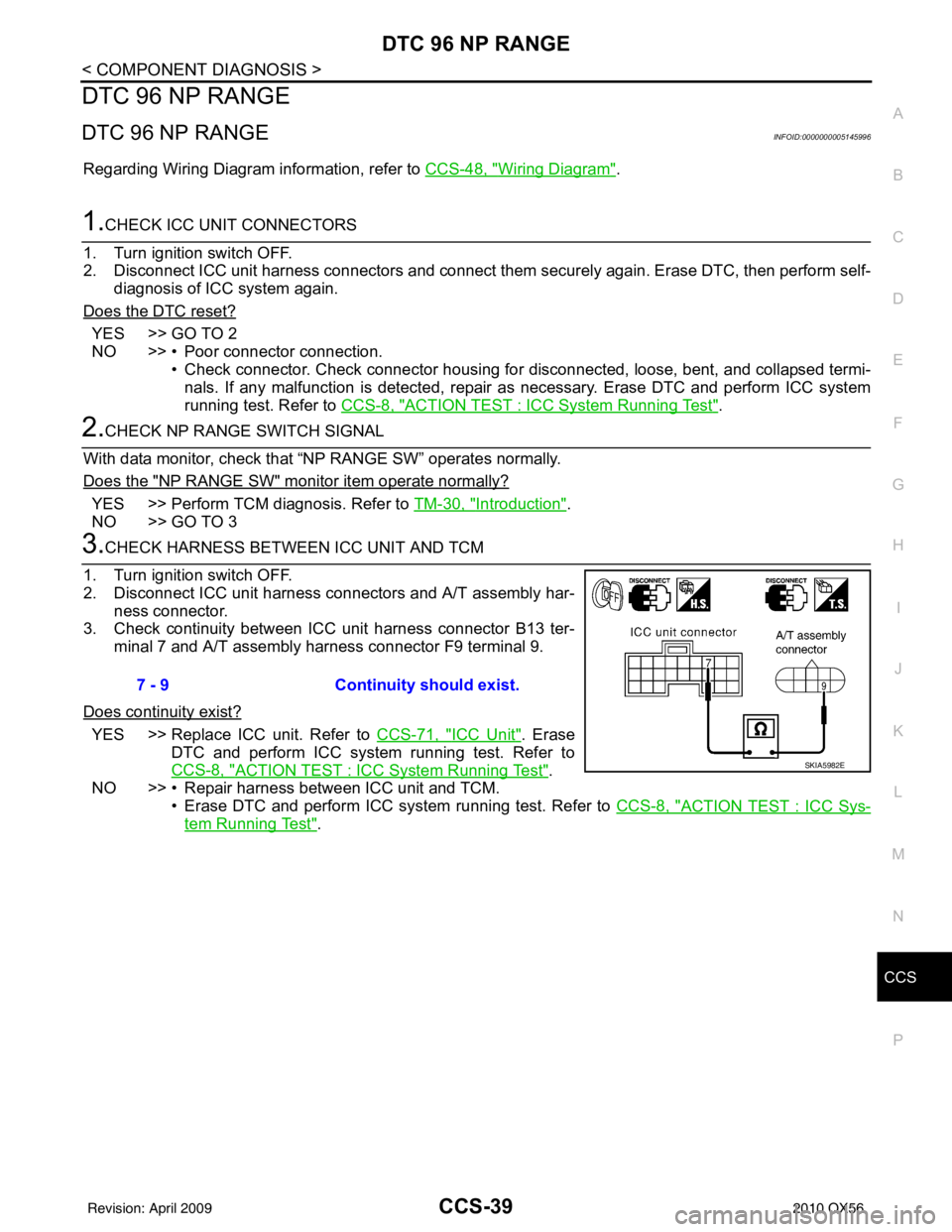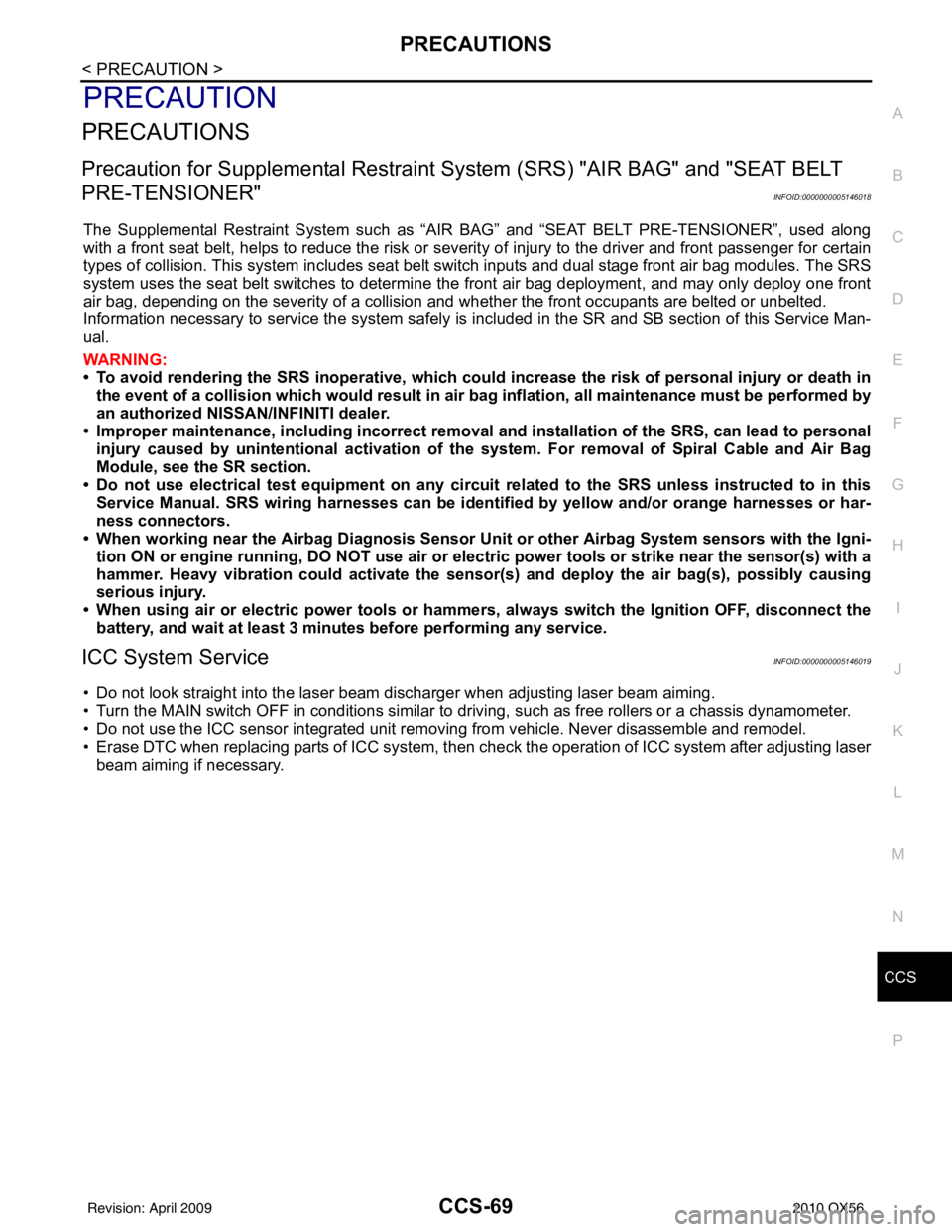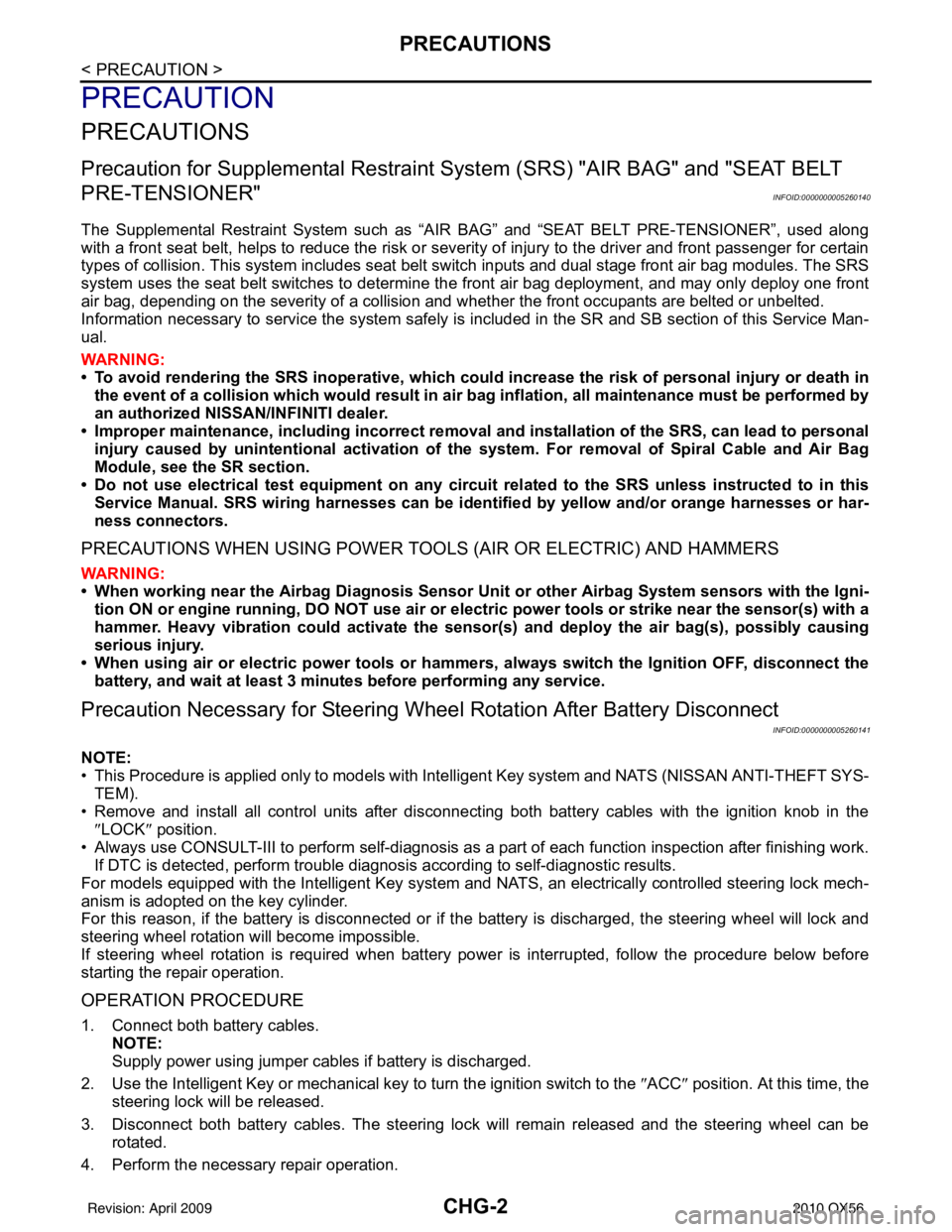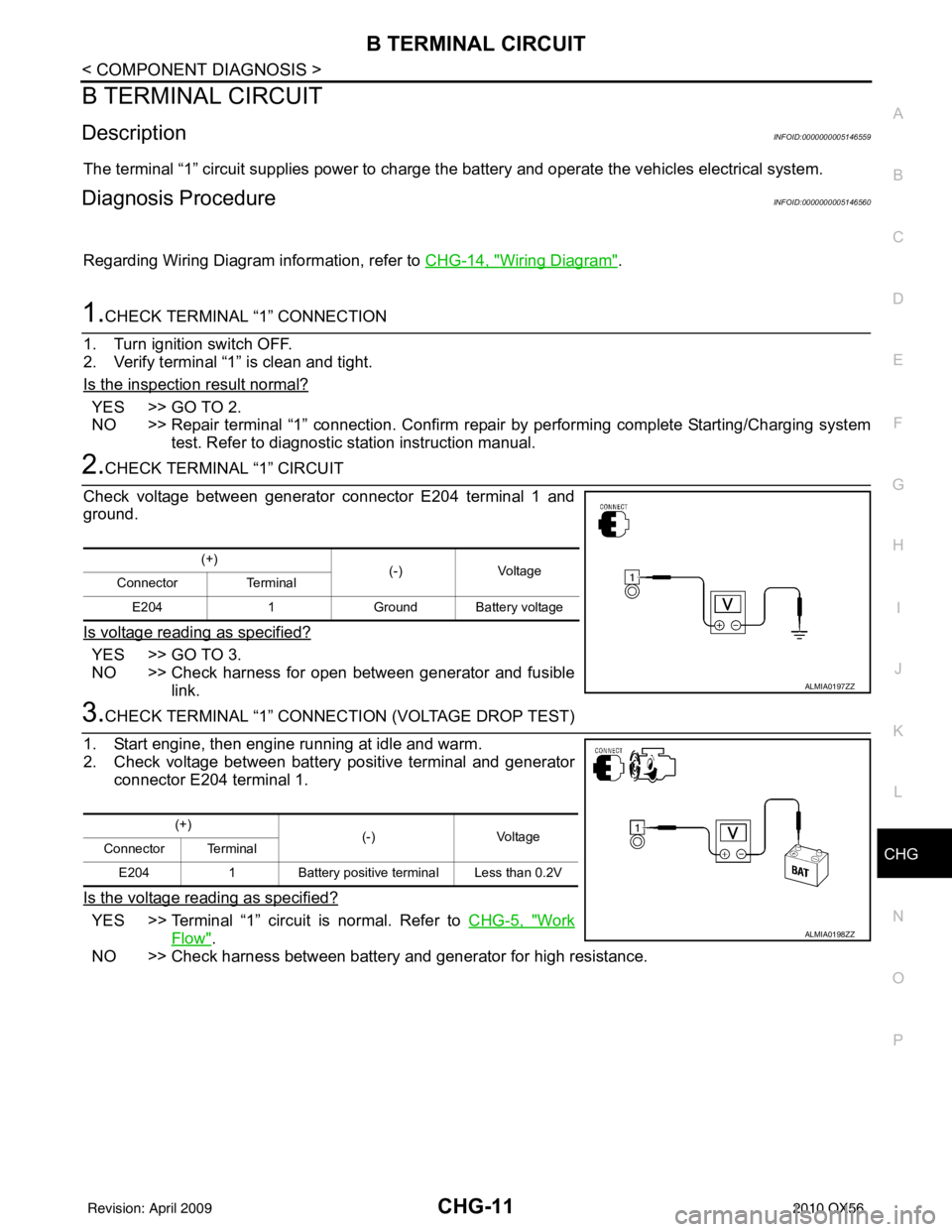Ignition switch INFINITI QX56 2010 Factory Service Manual
[x] Cancel search | Manufacturer: INFINITI, Model Year: 2010, Model line: QX56, Model: INFINITI QX56 2010Pages: 4210, PDF Size: 81.91 MB
Page 708 of 4210

CCS
DTC 96 NP RANGECCS-39
< COMPONENT DIAGNOSIS >
C
DE
F
G H
I
J
K L
M B
N P A
DTC 96 NP RANGE
DTC 96 NP RANGEINFOID:0000000005145996
Regarding Wiring Diagram information, refer to CCS-48, "Wiring Diagram".
1.CHECK ICC UNIT CONNECTORS
1. Turn ignition switch OFF.
2. Disconnect ICC unit harness connectors and connect them securely again. Erase DTC, then perform self- diagnosis of ICC system again.
Does the DTC reset?
YES >> GO TO 2
NO >> • Poor connector connection. • Check connector. Check connector housing for disconnected, loose, bent, and collapsed termi-nals. If any malfunction is detected, repair as necessary. Erase DTC and perform ICC system
running test. Refer to CCS-8, "
ACTION TEST : ICC System Running Test".
2.CHECK NP RANGE SWITCH SIGNAL
With data monitor, check that “NP RANGE SW” operates normally.
Does the "NP RANGE SW" monitor item operate normally?
YES >> Perform TCM diagnosis. Refer to TM-30, "Introduction".
NO >> GO TO 3
3.CHECK HARNESS BETWEEN ICC UNIT AND TCM
1. Turn ignition switch OFF.
2. Disconnect ICC unit harness connectors and A/T assembly har- ness connector.
3. Check continuity between ICC unit harness connector B13 ter- minal 7 and A/T assembly harness connector F9 terminal 9.
Does continuity exist?
YES >> Replace ICC unit. Refer to CCS-71, "ICC Unit". Erase
DTC and perform ICC system running test. Refer to
CCS-8, "
ACTION TEST : ICC System Running Test".
NO >> • Repair harness between ICC unit and TCM. • Erase DTC and perform ICC system running test. Refer to CCS-8, "
ACTION TEST : ICC Sys-
tem Running Test".
7 - 9 Continuity
should exist.
SKIA5982E
Revision: April 20092010 QX56
Page 716 of 4210

CCS
ICC UNITCCS-47
< ECU DIAGNOSIS >
C
DE
F
G H
I
J
K L
M B
N P A
ECU DIAGNOSIS
ICC UNIT
Terminal and Reference Value for ICC UnitINFOID:0000000005146004
Te r m i n a l Wire col-
or Item Condition
Voltage (V)
(Approx.)
Ignition
switch Operation
1W/L Battery power supply OFF— Battery voltage
2W/L
5 P CAN-L —— —
7 B/R N-P RANGE ON A/T selector lever in "P" or "N"Battery voltage
10 V/R Brake booster signal ON—
14 L CAN-H —— —
19 B Ground
ON——
20 B
29 BR/W ICC brake switch
(normally closed) Selector le-
ver: Not in “N” or “P” position Depress the brake
pedal
0
Release the brake
pedal Battery voltage
30 L TX —— —
33 R/B Ignition switch power supply ON —
Battery voltage
38 R/G Stop lamp switch
(normally open) OFFDepress the brake pedal
Release the brake pedal
0
39 V/W RX —— —
40 G Parking brake signal
ONParking brake is ON
0
Parking brake is OFF Battery voltage
42 R/B Ignition switch power supply —Battery voltage
46 B Ground ——
47 BR Stop lamp drive output signal Brake operating with ICC system
Battery voltage
Brake not operating with ICC sys-
tem 0
SKIA1243E
Revision: April 20092010 QX56
Page 728 of 4210

CCS
MAIN SWITCH DOES NOT TURN ON, MAIN SWITCH DOES NOT TURN OFF
CCS-59
< SYMPTOM DIAGNOSIS >
C
D E
F
G H
I
J
K L
M B
N P A
MAIN SWITCH DOES NOT TURN ON, MAIN SWITCH DOES NOT TURN
OFF
Diagnosis ProcedureINFOID:0000000005146009
NOTE:
• *1: The ICC system display in the combination meter does not illuminate.
• *2: The ICC system display in the combination meter remains powered.
1.CHECK ON/OFF SWITCH
With "DATA MONITOR", check that ON/OFF switch operates normally.
Does ON/OFF switch operate normally?
YES >> GO TO 2
NO >> GO TO 3
2.CHECK ICC UNIT CONNECTOR
1. Turn ignition switch OFF.
2. Disconnect ICC unit harness connectors.
3. Check connector housing for disconnected, loose, bent, and collapsed terminals.
Does the ICC unit pass inspection?
YES >> GO TO 3
NO >> • Poor connector connection. • Repair ICC unit connector. Erase DTC and perform ICC system running test. Refer to CCS-8,
"ACTION TEST : ICC System Running Test".
3.DIAGNOSIS CHECK
Perform self-diagnosis.
Is "CAN COMM CIRCUIT" indicated?
YES >> Refer to CCS-24, "DTC 20 CAN COMM CIRCUIT".
NO >> Refer to CCS-30, "
DTC 46 OPERATION SW CIRC".
Revision: April 20092010 QX56
Page 735 of 4210

CCS-66
< SYMPTOM DIAGNOSIS >
THE SYSTEM DOES NOT DETECT THE VEHICLE AHEAD AT ALL
THE SYSTEM DOES NOT DETECT THE VEHICLE AHEAD AT ALL
Diagnosis ProcedureINFOID:0000000005146016
1.VISUAL CHECK
With ignition switch turned ON (engine not started), che ck that all indicator lamps in ICC system display are
continuously lit. (Check for a missing segment in preceding vehicle detection display.)
Does the display operate normally?
YES >> GO TO 2
NO >> Check combination meter. Refer to MWI-22, "
Diagnosis Description".
2. VISUAL CHECK
Check ICC sensor window for contamination and foreign materials.
Is the ICC sensor window clean and free of obstruction?
YES >> If any contamination or foreign materials ar e found, remove them. Perform ICC system running
test. Refer to CCS-8, "
ACTION TEST : ICC System Running Test".
NO >> GO TO 3
3.VISUAL CHECK
Check ICC sensor window for cracks and scratches.
Is the ICC sensor window intact?
YES >> GO TO 4
NO >> • Replace ICC sensor and perform laser beam aiming adjustment. Refer to CCS-72, "
ICC Sen-
sor".
• Perform ICC system running test. Refer to CCS-8, "
ACTION TEST : ICC System Running Test".
4.ADJUST ICC SENSOR
• After performing laser beam aiming adjustment, perform ICC system running test. Refer to CCS-8, "
ACTION
TEST : ICC System Running Test". Check that preceding vehicle detection performance has been improved.
Is the ICC system operating normally?
YES >> INSPECTION END.
NO >> • Replace ICC sensor and perform laser beam aiming adjustment. Refer to CCS-72, "
ICC Sen-
sor".
• Perform ICC system running test. Refer to CCS-8, "
ACTION TEST : ICC System Running Test".
Revision: April 20092010 QX56
Page 738 of 4210

CCS
PRECAUTIONSCCS-69
< PRECAUTION >
C
DE
F
G H
I
J
K L
M B
N P A
PRECAUTION
PRECAUTIONS
Precaution for Supplemental Restraint System (SRS) "AIR BAG" and "SEAT BELT
PRE-TENSIONER"
INFOID:0000000005146018
The Supplemental Restraint System such as “AIR BAG” and “SEAT BELT PRE-TENSIONER”, used along
with a front seat belt, helps to reduce the risk or severi ty of injury to the driver and front passenger for certain
types of collision. This system includes seat belt switch inputs and dual stage front air bag modules. The SRS
system uses the seat belt switches to determine the front air bag deployment, and may only deploy one front
air bag, depending on the severity of a collision and w hether the front occupants are belted or unbelted.
Information necessary to service the system safely is included in the SR and SB section of this Service Man-
ual.
WARNING:
• To avoid rendering the SRS inoper ative, which could increase the risk of personal injury or death in
the event of a collision which would result in air bag inflation, all maintenance must be performed by
an authorized NISSAN/INFINITI dealer.
• Improper maintenance, including in correct removal and installation of the SRS, can lead to personal
injury caused by unintentional act ivation of the system. For removal of Spiral Cable and Air Bag
Module, see the SR section.
• Do not use electrical test equipm ent on any circuit related to the SRS unless instructed to in this
Service Manual. SRS wiring harnesses can be identi fied by yellow and/or orange harnesses or har-
ness connectors.
• When working near the Airbag Diagnosis Sensor Un it or other Airbag System sensors with the Igni-
tion ON or engine running, DO NOT use air or el ectric power tools or strike near the sensor(s) with a
hammer. Heavy vibration could activate the sensor( s) and deploy the air bag(s), possibly causing
serious injury.
• When using air or electric power tools or hammers, always switch the Ignition OFF, disconnect the battery, and wait at least 3 minutes before performing any service.
ICC System ServiceINFOID:0000000005146019
• Do not look straight into the laser beam discharger when adjusting laser beam aiming.
• Turn the MAIN switch OFF in conditions similar to dr iving, such as free rollers or a chassis dynamometer.
• Do not use the ICC sensor integrated unit removing from vehicle. Never disassemble and remodel.
• Erase DTC when replacing parts of ICC system, then c heck the operation of ICC system after adjusting laser
beam aiming if necessary.
Revision: April 20092010 QX56
Page 744 of 4210

CHG-2
< PRECAUTION >
PRECAUTIONS
PRECAUTION
PRECAUTIONS
Precaution for Supplemental Restraint System (SRS) "AIR BAG" and "SEAT BELT
PRE-TENSIONER"
INFOID:0000000005260140
The Supplemental Restraint System such as “A IR BAG” and “SEAT BELT PRE-TENSIONER”, used along
with a front seat belt, helps to reduce the risk or severity of injury to the driver and front passenger for certain
types of collision. This system includes seat belt switch inputs and dual stage front air bag modules. The SRS
system uses the seat belt switches to determine the front air bag deployment, and may only deploy one front
air bag, depending on the severity of a collision and w hether the front occupants are belted or unbelted.
Information necessary to service the system safely is included in the SR and SB section of this Service Man-
ual.
WARNING:
• To avoid rendering the SRS inopera tive, which could increase the risk of personal injury or death in
the event of a collision which would result in air bag inflation, all maintenance must be performed by
an authorized NISSAN/INFINITI dealer.
• Improper maintenance, including in correct removal and installation of the SRS, can lead to personal
injury caused by unintent ional activation of the system. For re moval of Spiral Cable and Air Bag
Module, see the SR section.
• Do not use electrical test equipmen t on any circuit related to the SRS unless instructed to in this
Service Manual. SRS wiring harn esses can be identified by yellow and/or orange harnesses or har-
ness connectors.
PRECAUTIONS WHEN USING POWER TOOLS (AIR OR ELECTRIC) AND HAMMERS
WARNING:
• When working near the Airbag Diagnosis Sensor Unit or other Airbag System sensors with the Igni-
tion ON or engine running, DO NOT use air or electri c power tools or strike near the sensor(s) with a
hammer. Heavy vibration could activate the sensor( s) and deploy the air bag(s), possibly causing
serious injury.
• When using air or electric power tools or hammers , always switch the Ignition OFF, disconnect the
battery, and wait at least 3 minu tes before performing any service.
Precaution Necessary for Steering W heel Rotation After Battery Disconnect
INFOID:0000000005260141
NOTE:
• This Procedure is applied only to models with Intelligent Key system and NATS (NISSAN ANTI-THEFT SYS-
TEM).
• Remove and install all control units after disconnecting both battery cables with the ignition knob in the
″LOCK ″ position.
• Always use CONSULT-III to perform self-diagnosis as a part of each function inspection after finishing work.
If DTC is detected, perform trouble diagnosis according to self-diagnostic results.
For models equipped with the Intelligent Key system and NATS, an electrically controlled steering lock mech-
anism is adopted on the key cylinder.
For this reason, if the battery is disconnected or if the battery is discharged, the steering wheel will lock and
steering wheel rotation will become impossible.
If steering wheel rotation is required when battery pow er is interrupted, follow the procedure below before
starting the repair operation.
OPERATION PROCEDURE
1. Connect both battery cables. NOTE:
Supply power using jumper cables if battery is discharged.
2. Use the Intelligent Key or mechanical key to turn the ignition switch to the ″ACC ″ position. At this time, the
steering lock will be released.
3. Disconnect both battery cables. The steering lock will remain released and the steering wheel can be rotated.
4. Perform the necessary repair operation.
Revision: April 20092010 QX56
Page 745 of 4210

CHG
PRECAUTIONSCHG-3
< PRECAUTION >
C
DE
F
G H
I
J
K L
B A
O P
N
5. When the repair work is completed, return the ignition switch to the
″LOCK ″ position before connecting
the battery cables. (At this time, the steering lock mechanism will engage.)
6. Perform a self-diagnosis check of al l control units using CONSULT-III.
Precaution for Power Generation Variable Voltage Control SystemINFOID:0000000005146547
CAUTION:
For this model, the battery current sensor that is installed to the negative battery cable measures the
charging/discharging current of the battery and performs various engine controls. If an electrical com-
ponent is connected directly to the negative battery terminal, the current flowing through that compo-
nent will not be measured by the battery current sensor. This condition may cause a malfunction of
the engine control system and battery discharge m ay occur. Do not connect an electrical component
or ground wire directly to the battery terminal.
Revision: April 20092010 QX56
Page 750 of 4210

CHG-8
< COMPONENT DIAGNOSIS >
CHARGING SYSTEM PRELIMINARY INSPECTION
COMPONENT DIAGNOSIS
CHARGING SYSTEM PRELIMINARY INSPECTION
Inspection ProcedureINFOID:0000000005146557
1.CHECK BATTERY TERMINALS CONNECTION
Check if battery terminals are clean and tight.
Is the inspection result normal?
YES >> GO TO 2.
NO >> Repair battery terminals connection.
2.CHECK FUSE
Check for blown fuse and fusible link.
Is the inspection result normal?
YES >> GO TO 3.
NO >> Be sure to eliminate cause of malfunction before installing new fuse or fusible link.
3.CHECK GENERATOR GROUND TERMINAL CONNECTION
Verify connector E206 terminal 5 (generator ground harness) is clean and tight.
Is the inspection result normal?
YES >> GO TO 4.
NO >> Repair connection.
4.CHECK DRIVE BELT TENSION
Check drive belt tension. Refer to EM-13, "
Checking Drive Belts".
Is the inspection result normal?
YES >> Inspection End.
NO >> Repair as needed.
Unit Power source (Power supply terminals) Fuse or Fusible Link
Generator Battery (terminal 3)
Fuse 30
Battery (terminal 1) Fusible Link A
Combination meter Ignition switch ON (terminal 2) Fuse 14
Revision: April 20092010 QX56
Page 752 of 4210

CHG-10
< COMPONENT DIAGNOSIS >
POWER GENERATION VOLTAGE VARIABLE CONTROL SYSTEM OPERATION
INSPECTION
1. Turn ignition switch OFF.
2. Disconnect generator connector E205 and IPDM E/R connector
E122.
3. Check continuity between generator harness connector E205 (A) terminal 4 and IPDM E/R harness connector E122 (B) termi-
nal 37.
4. Check continuity between generator harness connector E122 (A) terminal 4 and ground.
Are the continuity test results as specified?
YES >> Replace IPDM E/R. Refer to PCS-35, "Removal and Installation of IPDM E/R".
NO >> Repair harness or connector between IPDM E/R and generator.
AB Continuity
Connector Terminal Connector Terminal
E205 4E122 37Yes
A —Contin u it y
Connector Terminal
E205 4Ground No
ALMIA0196ZZ
Revision: April 20092010 QX56
Page 753 of 4210

CHG
B TERMINAL CIRCUITCHG-11
< COMPONENT DIAGNOSIS >
C
DE
F
G H
I
J
K L
B A
O P
N
B TERMINAL CIRCUIT
DescriptionINFOID:0000000005146559
The terminal “1” circuit supplies power to charge the battery and operate the vehicles electrical system.
Diagnosis ProcedureINFOID:0000000005146560
Regarding Wiring Diagram information, refer to
CHG-14, "Wiring Diagram".
1.CHECK TERMINAL “1” CONNECTION
1. Turn ignition switch OFF.
2. Verify terminal “1” is clean and tight.
Is the inspection result normal?
YES >> GO TO 2.
NO >> Repair terminal “1” connection. Confirm repa ir by performing complete Starting/Charging system
test. Refer to diagnostic station instruction manual.
2.CHECK TERMINAL “1” CIRCUIT
Check voltage between generator connector E204 terminal 1 and
ground.
Is voltage reading as specified?
YES >> GO TO 3.
NO >> Check harness for open between generator and fusible link.
3.CHECK TERMINAL “1” CONNECTION (VOLTAGE DROP TEST)
1. Start engine, then engine running at idle and warm.
2. Check voltage between battery positive terminal and generator connector E204 terminal 1.
Is the voltage reading as specified?
YES >> Terminal “1” circuit is normal. Refer to CHG-5, "Work
Flow".
NO >> Check harness between battery and generator for high resistance.
(+) (-) Voltage
Connector Terminal
E204 1Ground Battery voltage
ALMIA0197ZZ
(+)
(-)Voltage
Connector Terminal
E204 1 Battery positive terminal Less than 0.2V
ALMIA0198ZZ
Revision: April 20092010 QX56